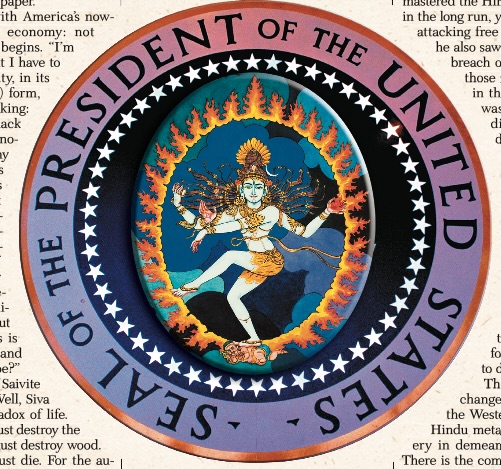The Philadelphia Inquirer newspaper is an unlikely place to encounter a dissertation on Siva Nataraja–especially when it is written by the newspaper’s editorial page editor and explains why America would be better off if the country imbibed a bit more Hinduism and the next president learned to “Dance with Siva.” Chris Satullo is the surprising author of the piece, entitled “Center Square, Econ 101: Duality of Hinduism Could Help, ” which appeared in the March 14, 2004 edition of the popular newspaper.
“Here’s my problem with America’s now-raging debate on the economy: not enough Hinduism, ” he begins. “I’m a churchgoer myself. But I have to concede this: Christianity, in its simplistic (i.e., political) form, is prone to binary thinking: good/evil, white hat/black hat. Applied to the economy, this habit leads many folks to cling to specious couplets: corporations bad/unions good; tax cuts good/social spending bad. Think, by contrast, of Hindu philosophy. One of the chief Hindu Gods is a fellow named Siva. The Destroyer–that’s the moniker He mostly goes by. But another of His epithets is the Creator. Destroyer and Creator? How can that be?”
With a decent grasp of Saivite theology, he goes on, “Well, Siva embodies a central paradox of life. To create the new, you must destroy the old. To create fire, you must destroy wood. To make oil, animals must die. For the automobile to prevail, blacksmiths must suffer. For Bill Gates to rise, the typewriter repairman must fall. Siva destroys; Siva creates.”
He applies this concept to the development of capitalism in America. “Look back over America’s long love affair with free-market capitalism. The net result clearly has been more wealth and more health for more people. This is so, even though the ledger includes much suffering, injustice, inequality and corruption, much strain on families and on nature. The point is: free-market capitalism is Siva. It is neither all good nor all bad; it is what it is, at once creative and destructive. The point is: The job of government is not to ‘run’ the economy. Siva does not submit to a harness. Much waste and mischief occur under that delusion. Yet, neither is it government’s role just to worship free-market capitalism, to hand over the keys. Capitalism can do too much damage to public goods. In a democratic republic, those goods should be valued more than mere wealth. They include little things such as, oh, justice, equal opportunity, stable communities, education, health care, parks, clean air. Government’s job is to defend and expand those public goods. Free markets make that job harder, because their mania for efficiency and innovation creates victims and inequalities. Yet free markets also make that job possible, by generating wealth and innovation which government can tap to heal victims and foster public goods. Any leader worthy of the name must master this dualism. A good leader needs some Hindu in him.”
Satullo goes on to criticize President Bush as “rigid ” and a worshiper of capitalism. “Not only isn’t he much of a Hindu; he needs work on the Christian thing, too, ” concludes Satullo–because, in his opinion, the President isn’t showing enough mercy towards those hurt by economic problems. Satullo takes a few equalizing swipes at the Democrats, then concludes his piece. “God, I miss Bill Clinton, even more than I want to slap him. He was the Democrat who got it, who mastered the Hindu dualism. He knew that, in the long run, you hurt working people by attacking free trade and innovation. But he also saw that it is an unpardonable breach of faith to ignore the harm those forces do to some workers in the short run. Even Clinton wasn’t smart enough to predict today’s dilemma. He didn’t anticipate off-shoring, didn’t see that Bangalore might soon start eating San Jose’s lunch. Maybe off-shoring is just a ripplet that hysteria has hyped into a tsunami. That is a Democratic habit, after all. I’m not smart enough to know. What worries me is none of the guys running for president seems to be either. I’m looking for a sign, for someone who knows how to dance with Siva.”
The editorial is a welcome change from a general trend in the Western press to use or refer to Hindu metaphors, concepts and imagery in demeaning and derogatory ways. There is the common phrase in economics itself, “the Hindu rate of growth.” The term refers to India’s post-independence Gross National Product growth rate of two to three percent a year under Nehru’s socialism. It was the slowest in the region, and a pattern which only accelerated in the 1980s. One never hears of a “Muslim rate of growth ” to describe Pakistan’s economy, or a “Christian rate of growth ” to describe Haiti’s, both with lower GNP’s than India. Our kudos go to editor Satullo for an insightful and useful application of Hindu philosophy to the problems of modern America.”


